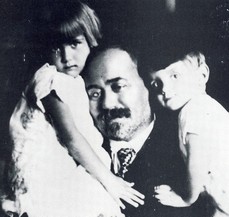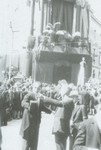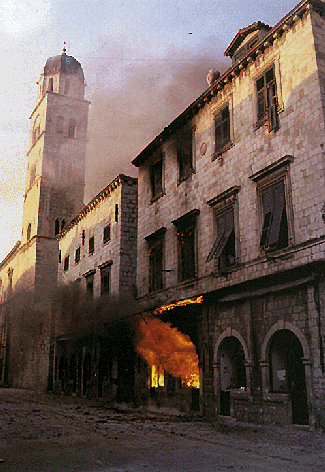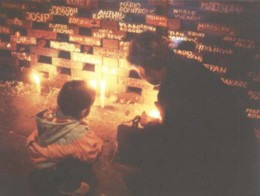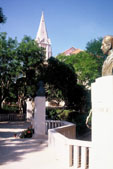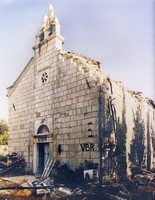The period of Croatia within ex-Yugoslavia
(1918-1941, 1945-1991)
© by Darko Zubrinic, Zagreb (1995) It
is interesting that the greatest
promoters of creating a state of the Southern Slavs, i.e. the idea of
Yugoslavia, were the Croats (Josip Juraj
Strossmayer on the first place),
but they did not conceive
of it as
the centralized, Serb-dominated state. Their aim was to preserve the
Croatian national identity and the sovereignty of Croatia and to
organize the new state of South Slavs on a confederative
basis.
See Strossmayer's absolute
no to union with Serbs by
academician Josip Pecaric (in Croatian).
That is why the Kingdom of the Serbs, Croats and Slovenes, established in 1918, did not obtain the confirmation and permission of the Croatian Parliament. This state, created in 1918 from the Austro-Hungarian part, (Slovenia, Croatia, Vojvodina, Bosnia-Herzegovina) and Serbia and Montenegro, which were opposing sides during the First World War (1914-1918), contained a germ of numerous future conflicts. It was composed of different traditions, religions, nations, languages and scripts.
At that time the region of Vojvodina did not include Srijem (the territory between rivers Sava and Danube), that before 1918 belonged to Croatia. Vojvodina belonged to Hungary before 1918.
The idea of Yugoslavia was in fact the best opportunity for Serbian nationalists to create the Greater Serbia, which was completed in 1918 according to the 1844 secret program. Montenegro lost its independence in 1918 after being brutally annexed to Serbia. The independence of Montenegro was regained in 1945 within the Tito's Yugoslavia.
The whole property of the Austro-Hungarian state and booty was confiscated by the Serbian authorities. Immediately after 1918 all the leading positions in the army were seized by Serbian officers, who treated Croatia as a hostile territory in the common state (it was publicly declared in 1919!). On the other hand, it was presented to Europe as if the Croats had entered willingly the union with Serbia.
The Serbian legislature, juridical and military 19th century law was simply implemented into the new state without changes and without consultations with the Croats. It resulted in unbearable terror and persecutions of Croatian peasants and intellectuals. Croatian teachers were retired and persecuted.
Equally difficult was the economic terror of the Belgrade government. The Croats were not proportionally represented in the government and diplomatic corps. The old currencies - Serbian dinars and Croatian (Austrian) crowns, which in 1918 had the same value, were in 1919 changed for the new dinar in the following ratio: 1 dinar = 4 crowns!
On the other hand,
- taxes were lower in Serbia,
- the major part of foreign loans was spent in Serbia,
- high administrative posts were filled exclusively with the Serbs (civil servants in Croatia were appointed by the central administration in Belgrade).
Very cruel persecutions of the Muslims by the Serbs resulted in their massive emigration to Turkey soon after the foundation of Kingdom of Serbs, Croats and Slovenes in 1918, where Serbia was the leading and privileged nation. The same happened to several hundred thousand Muslims soon after the Second World War. We have witnessed the same persecutions since 1992. Only in the first half of 1992 about 250,000 Croats and Muslims were exiled from Bosnia to Croatia, as an adding to its own 350,000 citizens exiled from the occupied areas.
One of the most outstanding and most popular personalities in the Croatian political history was Stjepan Radic (1871-1928), the leader of the Croatian Peasant Party, assassinated in the Yugoslav parliament in Belgrade (capital of present Serbia) in 1928 together with his colleagues. The assassination was organized at the Royal court in Belgrade. Radic strived to renew the Croatian sovereignty and the economic and cultural emancipation of Croatia. He wanted the state of the Southern Slavs to be reorganized on confederative basis, without Serbian hegemony.
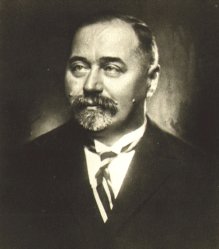
For more information see:
- Stjepan Radic, His Life - His party - His politics, written by Ante Cuvalo,
- The significance of Stjepan Radic to the Croatian nation in the past and present (1825-1871), by Jure Petricevic
- Stjepan Radic: The Russian branch of our Jelacic's
- Stjepan Radić u viđenju danske književnice Karin Michaelis
Stjepan Radic completed his studies in France, on École Libre des Sciences Politiques in Paris, with the thesis La Croatie actuelle et les Slaves du sud.
- During the 1991-1998 Serbian occupation of the city of Vukovar, one of its streets was renamed after Radic's assassin. International community insists on Croatia that the name of assassin of one of greatest Croats of the 20th century is left for the time being. It seems that the Croats will endure this insult, in the name of peaceful reintegration of the Vukovar region which had started in the beginning of 1998 under the auspices of UN.
The
culmination of the Serbian police
terror took place during the personal dictatorship of king Aleksandar
Karadzordevic since 1929. One of the historical documents from that
period, showing `methods' of the Serbian police and administration, is
a bill [JPG]
on 13 dinars and 15 paras charged to a
Croatian family in 1934
for five bullets fired at the father, who was sentenced to death. The
families were persuaded even to pay the `expenses' of the execution
within eight days, under the threat of confiscation of their property.
Croatian archbishop Alojzije
Stepinac reported
about this event to the French diplomat Ernest Pezet in 1935.
For
more details see
- A photocopy of the bill received by the son of Ivan Varga to pay 13.15 dinars for the five bullets by which his father was killed on January 11, 1934 (see the bottom of the page).
- [Cristophe Dolbeau], and Marija Novak: "Stepinac o srpskom teroru u Meddimurju", Glas koncila, May 17, 1998, p. 20.
Belgrade made use of the world economic crises in 1929 to destroy the Croatian banking system, which had been the strongest in Yugoslavia.
Out of 165 active army generals of the Kingdom of Yugoslavia (1929 - 1941) only 2 were the Croats, and - 161 Serbs. In 1937, out of 22 Yugoslav ambassadors 20 were Serbs and only two Croats, see [Peric, p 42].
All this led to the formation of the Croatian separatist group called Ustasha, which gathered around Ante Pavelic (1889-1959). It had been supported by the fascist Italy.
 Croatian
scientists were also victims of the Greater-Serbian terror. So Milan
Sufflay, historian of
international reputation known by his
numerous scientific contributions, especially in the field of
albanology, was assassinated by a steel rod on a street in the center
of Zagreb in 1931. After the dramatic events that followed, Albert Einstein and Heinrich Mann
sent an
appeal to the International League of Human Rights in Paris to protect
Croats from the terror and persecutions of the Serbian police. It was
also published in the New York Times (6th May 1931). As we learn from
this letter, the newspapers in Zagreb were not allowed to report about
Sufflay's activity; it was not allowed to attach a half-mast flag on
the main building of the University of Zagreb in his honour; the time
of the funeral could not be announced publicly, and even condolence
messages were not allowed to be telegraphed. In their letter Einstein
and Mann hold the Yugoslav king Aleksandar explicitly responsible for
the state terror over the Croats. The letter concludes that it
should not be tolerated that killings be allowed as a means to achieve
political goals. We should not allow killers to be promoted as national
heroes. The king himself was
assassinated by a Macedonian patriot
in Marseille in 1934 (there are indications that there was a
collaboration of the Macedonian Revolutionary Organization with the
Ustasha organization).
Croatian
scientists were also victims of the Greater-Serbian terror. So Milan
Sufflay, historian of
international reputation known by his
numerous scientific contributions, especially in the field of
albanology, was assassinated by a steel rod on a street in the center
of Zagreb in 1931. After the dramatic events that followed, Albert Einstein and Heinrich Mann
sent an
appeal to the International League of Human Rights in Paris to protect
Croats from the terror and persecutions of the Serbian police. It was
also published in the New York Times (6th May 1931). As we learn from
this letter, the newspapers in Zagreb were not allowed to report about
Sufflay's activity; it was not allowed to attach a half-mast flag on
the main building of the University of Zagreb in his honour; the time
of the funeral could not be announced publicly, and even condolence
messages were not allowed to be telegraphed. In their letter Einstein
and Mann hold the Yugoslav king Aleksandar explicitly responsible for
the state terror over the Croats. The letter concludes that it
should not be tolerated that killings be allowed as a means to achieve
political goals. We should not allow killers to be promoted as national
heroes. The king himself was
assassinated by a Macedonian patriot
in Marseille in 1934 (there are indications that there was a
collaboration of the Macedonian Revolutionary Organization with the
Ustasha organization).
- Albert Einstein and Heinrich Mann: Appeal on the occasion of killing of Professor Milan Sufflay in Zagreb
- New York Times (May 6, 1931): Einstein Accuses Yugoslavian Rulers in Savant's Murder,
- A Letter of Protest sent by American intellectuals organized by Roger N. Baldwin, Chairman of the International Committee for Political Prisoners, to the Yugoslav representative in Washington on November 24, 1933.
Milan Sufflay at the funeral of
Stjepan Radic in 1928, Zagreb
copyright by [Darko Sagrak: Dr Milan
pl. Sufflay...], on this web
with permission
An extremely valuable
account on the terrorist methods of the
Pan-Serbs in Yugoslavia between the two WWs has been written by Henri
Pozzi, a brave French diplomat
(his mother was English) and a close
witness, in his book Black
Hand over Europe, London, 1935.
"Black hand"
is the name of the Pan-Serbian secret terrorist organization, very
close to the Royal court in Belgrade. It was the "Black hand" that
organized the assassination of the Austrian archduke Ferdinand Habsburg
in Sarajevo in 1914, which meant the beginning of the First WW.
The
book contains an
important article The Story of
the Black Hand and the Great War
by a Montenegrin intellectual Voislav
M. Petrovich, p. 243-267. He
committed suicide in London in 1934
after a violent campaign instituted against him and threats of the
Black Hand. It is
interesting that Petrovich had published a Serbian grammar in London in
which he succeeded in getting the English Press to use the word
"Serbia" instead of "Servia".
All the best posts in Croatia were occupied by the Serbs. Around 1930 the situation in Croatia was to following (see Henri Pozzi, p.35):
- at the Croatian ministry of the Interior 113 out of 125 officials were Serbs,
- at the Foreign office 180 out of 219,
- at the Presidency of the council 13 out of 13,
- at the Ministry of Justice 113 out of 136,
- at the Securities Bank 196 out of 200,
- at the Court 30 out of 31.
- Croatia had to keep about sixty thousand Serb gendarmes, police and soldiers.
In 1934 the Croatian community in the USA sent
with 43,000 signatures of American Croats. The petition urged the League to secure the independence of Croatia from Yugoslavia on the plea that Yugoslavia was mistreating the Croats. It was initiated by Ivan A. Stipanovic (1890-1970), a parish priest in Youngstown, Ohio, USA. The petition began with a reference to Woodrow Wilson's plea for the right of self-determination. The memorandum was sent to embassies of all nations represented in the USA and to the Pope Pius at Rome. Signatures were collected during 1932 and 1933 in 26 American states, Washington, and in three provinces in Canada, and all of them authenticated by notaries public in these states. The petition was soon stolen from the Geneva archives of the League of Nations, see an article published in Youngstown Vindicator, 10th December 1934.
The tendency of administrative parcelization of Croatia that started in 1922 was revised by the establishment of the autonomous Croatia - Banovina Hrvatska - in 1939. It also included parts of Bosnia-Herzegovina.
After the military defeat of the Kingdom of Yugoslavia in 1941, parts of Croatia were annexed to Italy and Hungary, and the rest of Croatia was occupied by the Nazi Germany and Fascist Italy. In this part of Croatia and in Bosnia-Herzegovina the occupational forces enabled the formation of the Independent State of Croatia (NDH, Nezavisna drzava Hrvatska, 1941-1945), with its own fascist ustasha order introduced from Italy and Germany, and with Ante Pavelic as its president. It brought misfortune to many Serbs, Jews, Gypsies and Croats. The aim of the Ustasha regime was to have ethnically pure Croatian territories. Mass executions were organized in the infamous Jasenovac concentration camp, similar to those in Germany and Poland. A part of captives has been left to the German occupational rule in NDH and transported to concentration camps in Germany and Poland. There is no doubt that this was the darkest period of the Croatian history. For those wishing to obtain a more complete information on the history of Independent state of Croatia we recommend to consult an essay of Sentija in [Macan, Sentija]. We also recommend you to consult an extensive book of [Paul Garde].
John Kraljic (New York, USA): The New York Times, Croatia and History
Disappointment with the NDH came very soon. Forty days after its proclamation there came the "Rome agreement", in fact a dictate of the fascist Italy (Pavelic's protector in time of his emigration), by which large parts of Croatian national territory, including Dalmatia, had to be ceded to Italy, and Medimurje to Horthy's Hungary. The vassal status of NDH towards Hitler's Germany and Mussolini's Italy greatly reduced the initial support that NDH enjoyed among the Croats.
The Independent state of Croatia (NDH), though awaited by many who wanted to get rid of the Yugoslav terror, led to the new tragedy of the Croats. They were divided in two opposing parts - those who supported the Independent State of Croatia, and those who joined the Antifascist movement, which fought for the new Yugoslavia on federative basis, where the Croatian state would enjoy the same rights as others. Thus, however contradictory it may seem, both opposing parts of the Croatian population fought for the same goal - for free Croatia.
It should be noted that, though NDH had its fascist ustasha order introduced from Italy and Germany, never in the history there was any fascist (or ustasha) party in Croatia. This is a clear indication of the negative attitude of great majority of the Croats towards Fascism. On the other hand, in 1941 the Serbian Fascist Party has been founded in Belgrade by Dimitrije Ljotic, the principal Fascist ideologist of Serbia, Nedic's second in command. The Serbian government under General Milan Nedic, a close collaborator of the Nazi officials, proclaimed Belgrade to be the first "Judenfrei" city in Europe (see [Cohen] in Helsinki or Cohen's important book for more details). Belgrade was the only European capital that had concentration camps exclusively for Jews (Sajmiste and Banjica), see e.g. [Pecaric]. There are no holocaust memorial tablets in Belgrade, as is the case in the similar camps elsewhere in Europe. It is estimated that the number of victims is comparable to that in the Jasenovac camp.
Croatian population was mostly peasant, politically organized in the Croatian Peasant Party (HSS), by far the strongest in the country before 1941. Its strength stem from the popularity of Stjepan Radic, killed in the Belgrade parliament in 1928. Vladko Maček, who took over the leadership of HSS after Radic's assassination, had been imprisoned by the Ustasha regime in 1941 in Jasenovac, and then kept in custody. When the WW2 ended and Tito's communist regime started, the Croatian Peasant Party was forbidden.
An amazing antifascist case of "Stadium" in Croatian capital Zagreb is for sure without precedent in the history of WW2, in the part of Europe already occupied by nazists and fascists. In May 26, 1941, all secondary school pupils in Zagreb had to gather on a city stadium, lined in ranks. The ustasha officials ordered all Jews and Serbs to step forward. And what happened? ALL PUPILS stepped forward - Croats, Jews, and Serbs - aware of the police terror that awaited them.
On the other hand (also without precedent in the history of WW2), three months later, August 13, 1941, "An appeal to Serbian people" was signed by 545 leading Serbian intellectuals in Belgrade, including four archbishops, at least 81 university professors, artsits, etc. Two of the best known intellectuals are Aleksandar Belich, a linguist, one of the "scientific" founders of Greater Serbian program, and Viktor Novak, who became ardent communist after 1945, and wrote a voluminous Magnum Crimen accusing the Catholic Church and Cardinal Alojzije Stepinac for "collaboration with ustashis" (its "reliability" is well known; of course, his books are extensively cited by Serbian sources). The "Appeal" represented a public call to support Nazi occupying forces and local quislings in Serbia. Many of the signatories (the complete list can be seen in [Cohen], p. 158-172) became important figures after 1945 in Tito's Yugoslavia (!), and 28 of them even members of the Serbian Academy of Sciences and Arts. This Academy has created intellectual program for the unsuccessful project of Greater Serbia, i.e. Serbia extended to BiH and a large part of Croatia.
It is very little known that the famous Sarajevo Haggadah (Jewish Bible) has been saved from German Nazis by Jozo Petricevic, director of the Sarajevo Museum in 1941.
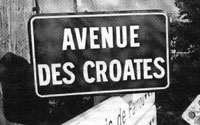 Here
we would like to mention a tragic fate of a division composed of
about 500-1000 Catholic and Muslim Croats
which has been sent by force to France in 1943 by the Nazis in order to
fight there. Originally this division was predicted to act as a
defensive formation exclusively on the Croatian soil. A rebellion of
the Croatian troops which took place in Villefranche-de-Rouergue
(capital of an arrondissement in the region of Aveyron) in September
1943 shows clearly the patriotism of Croatian soldiers. The goal of the
rebellion within Nazi troops was to approach the French Liberation
Movement and Anglo-Americans, and then to come back to Croatia. It had
a tragic outcome, with only a few who managed to escape. This
rebellion, the first within
the Nazi military system during
the
WW2, was highly esteemed by the French citizens of
Villefranche-de-Rouergue.
Here
we would like to mention a tragic fate of a division composed of
about 500-1000 Catholic and Muslim Croats
which has been sent by force to France in 1943 by the Nazis in order to
fight there. Originally this division was predicted to act as a
defensive formation exclusively on the Croatian soil. A rebellion of
the Croatian troops which took place in Villefranche-de-Rouergue
(capital of an arrondissement in the region of Aveyron) in September
1943 shows clearly the patriotism of Croatian soldiers. The goal of the
rebellion within Nazi troops was to approach the French Liberation
Movement and Anglo-Americans, and then to come back to Croatia. It had
a tragic outcome, with only a few who managed to escape. This
rebellion, the first within
the Nazi military system during
the
WW2, was highly esteemed by the French citizens of
Villefranche-de-Rouergue.
When the city was
liberated in 1944, they
decided to pay tribute to these tragic victims by naming one of its
streets as Avenue des Croates.
The French witnesses called this
insurrection la
révolte des Croates.
According to Louis
Erignac, Villefranche-de-Rouergue was the first free city of occupied
France. Even today citizens of the city regularly commemorate this
tragic event (September 14th). In 1952 the participants of the Croatian
Partisan Movement planned to build up a memorial to the Croatian
victims in Villefranche-de-Rouergue (with a sculpture of Vanja Radaus),
but this has been prevented by the (ex)Yugoslav government in Belgrade
under the pretext that in this way the "quislings" would be honoured.
For more details see [Croatie/France],
and a
monograph [Grmek,
Lambrichs] related to this
subject.
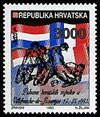 See
also Louis Erignac: La
révolte des Croates,
published in 1980 and 1988.
See
also Louis Erignac: La
révolte des Croates,
published in 1980 and 1988. - Yves Molly, a French poet, wrote a poem Fils de Croatie (Croatian sons).
Croatia gave a great contribution to the victory of the Antifascist coalition in the Second World War. Out of all the brigades and divisions of Tito's Liberation Movement created on the territory of former Yugoslavia, the great majority was from Croatia.
We find it pertinent to cite the following words of Georges-Marie Chenu, Ministre plénipotentiaire, the first Ambassador of France in Zagreb (1992-94), see [Gregory Peroche], p. 10:
Pendant trop longtemps, l'opinion publique française ignora que, parmi les résistants au nazisme dans la région, plus de la moitié étaient croates ou slovènes et qu'au début de 1944 - les combats se prolongèrent après la capitulation du Reich - il y avait en Croatie autant de résistants actifs qu'en France, pays neuf fois plus peuplé!
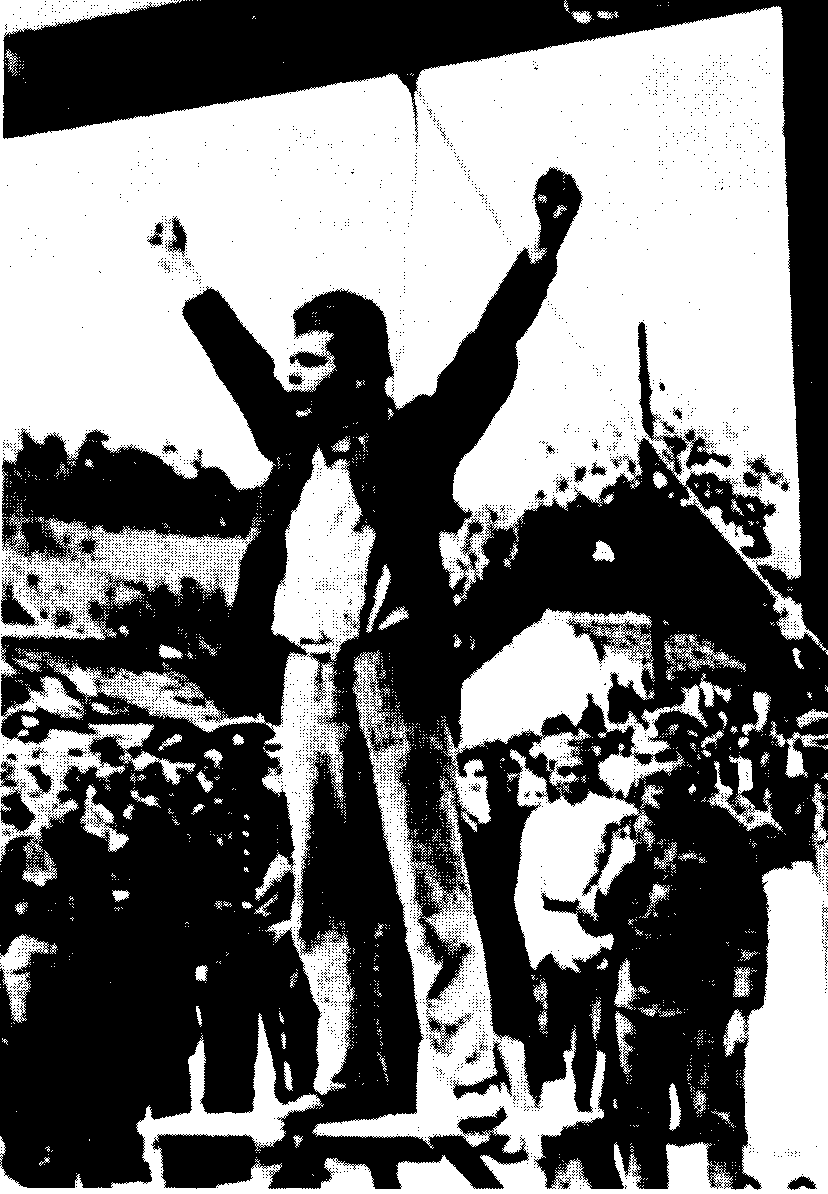 Stjepan
Filipovic (1916 -1942), a
Croatian antifascist born in Opuzen, in Dalmatian part of Croatia, was
hanged publicly in the city of Valjevo in Serbia. The beginning of WW2
found him in Serbia where he was working as a factory worker. His grand
monument in Valjevo still exists, with his serbized name (Stevan).
Present Serbain sources (as well as former Yugoslav sources) present
him as a Serb hanged by the Germans. There exists a photo taken just a
moment before his hanging, where one can clearly see Serbian chetniks
together with German officers, one of many proofs of their very close
collaboration. This amazing photo of a victim of the fascist terror is
also exhibited in the building of UN in New York. Whose terror? The
nationality of this Croatian victim of the Serbian and German Fascism
is not indicated. See [Ljubica Stefan]
for
more details.
Stjepan
Filipovic (1916 -1942), a
Croatian antifascist born in Opuzen, in Dalmatian part of Croatia, was
hanged publicly in the city of Valjevo in Serbia. The beginning of WW2
found him in Serbia where he was working as a factory worker. His grand
monument in Valjevo still exists, with his serbized name (Stevan).
Present Serbain sources (as well as former Yugoslav sources) present
him as a Serb hanged by the Germans. There exists a photo taken just a
moment before his hanging, where one can clearly see Serbian chetniks
together with German officers, one of many proofs of their very close
collaboration. This amazing photo of a victim of the fascist terror is
also exhibited in the building of UN in New York. Whose terror? The
nationality of this Croatian victim of the Serbian and German Fascism
is not indicated. See [Ljubica Stefan]
for
more details.
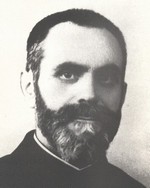
Petar Perica (1881-1944) composed two sacral songs still extremely popular among the Croats: Do nebesa nek se ori (in 1900, at the age of 19) and Rajska Djevo (in 1904, at the age of 23). In 1901 he entered the Society of Jesus. Killed by communist partisans in 1944 on the islet of Daksa near Dubrovnik.
Hrvoje Kacic: "Dubrovacke zrtve", Jugokomunisticki teror na hrvatskom jugu 1944. i poratnim godinama (pocetak Bleiburga)
After the capitulation of Italy in 1943 the Anti-fascist council for the national liberation of Croatia (ZAVNOH) decided to join Istria, Rijeka, Zadar, the islands and other occupied areas to Croatia. All agreements made by the NDH and the former Kingdom of Yugoslavia with the fascist Italy were torn up.
Not only the Croats participated in the Anti-fascist war in Croatia, but also a part of the Serbian minority in Croatia and many other ethnical groups. A part of Serbs in Croatia joined the Greater-Serbian extremist organization (chetniks) which collaborated with the occupational forces.
The mass crimes against the Croats and Muslim Slavs committed by the Serbian chetnik movement were particularly cruel. The aim was to create ethnically pure Greater Serbia that would include Bosnia-Herzegovina and a large part of Croatia.
Ljubica Stefan: Americko gostoprimstvo zlocincu Momcilu Djuicu, Hrvatsko Slovo, November 6, 1998
By the end of the Second World War the remaining parts of the NDH Army together with many civilians began to withdraw to Austria, and in the battles until 15 May 1945 they surrendered to the Yugoslav Army, which surrounded them. Many people who flew to Austria in mid-May 1945, were sent back by the British military authorities (who had jurisdiction over a part of Austria) to the Yugoslav partisans. Tens of thousands of soldiers and civil captives were killed after the capitulation. The symbol of the Croatian tragedy is the slaughter of Croats near the city of Bleiburg in Austria. Those who were not killed immediately, were forced to walk up to 700-800 km. (the infamous "death marches") with mass executions on the way, organized mostly by Serbian partisan officers. These death marches are known among the Croats as "krizni put" (Way of the Cross). Many sites of mass executions were discovered throughout Croatia and Slovenia after democratic changes in 1990.
- For more information see [Tolstoy], [Zugaj], [Leljak]
- Zvonko Springer (Salzburg): Withdrawal and Death March, ...During recent construction works [in 2000] of a highway near Maribor (Republic of Slovenia) the roadbed crossed a filled in 1941 anti-tank trench whose length, one reckons, was some 2.5km. On the excavated part of it of some 70m one found and had to remove thousands of bones of some 1,200 skeletons of entirely decomposed male bodies. Considering some 15 skeletons per meter (!) in that excavated trench part only, one derives to say over 30,000 killed males being buried there... [the place of this horrific mass slaughter in Slovenia is still not marked by any visible sign].
- In 1999 the resources from the Republic of Slovenia reported of as many as 110 mass graves of Croats discovered in this state, victims of the "Way of the Cross" in 1945 immediately after the end of WW2. Among them there were not only soldiers, but also a large number of civilians. The Slovenian public was shocked by the size and number of these graves.
- In 2001 Slovenian sources reported of as many as 296 mass graves on their territory, and an estimate of about 190,000 Croats killed immediately after the end of WW2 (May 1945 and later), mostly Croats. Only in the region of Tezno woods Slovenian sources estimate about 60-80,000 killed. Many children's bones have been found among the remains of victims.
- Pieteta
It is sad that the Croats in present day Slovenia do not enjoy the status of national minority, contrary to the much smaller Slovenian community in Croatia. Note that the second name Horvat is among the most widespread in Slovenia.
See a list of 456 Croatian Catholic priests, theology students and religious brothers killed by communists and Serbian chetniks in the former Yugoslavia during and after World War II, written by Ante Cuvalo. A detailed and well documented scholarly monograph concerning the chetnik crimes in Croatia and in Bosnia-Herzegovina is [Dizdar, Sobolevski].
One
of the great tragedies of the Second
World War was the slaughter of 12,000 Polish officers in the Katyn
wood (Poland) in 1940. Also a
mass grave with more than thousand
Ukrainian peasants and workers in Vinica
(Ukraine), killed in
1938, was found by Germans. The Soviets accused Germans for these
horrible crimes, and vice versa. Among leading European experts from 12
countries in pathological anatomy, two Croatian specialists were
invited by the International Committee of the Red Cross to take part in
the investigation in 1943: prof.dr. Eduard
Miloslavic and prof.dr. Ljudevit
Jurak. The result was that this
cold-blooded mass slaughter was
committed by the Soviets. Prof.dr. Miloslavic emigrated in time from
ex-Yugoslavia to the USA by the end of WWII, while prof. Jurak remained
in Zagreb, and was imprisoned on the demand of the Russian NKVD by the
Yugoslav communists in May 1945. It was offered to him that he would
not be accused as a military criminal and that his life would be spared
if he declared that his report for the Red Cross Committee had been
signed under pressure. He refused to do so, fully aware of the
consequence.
For
example, NKVD officers forced Bulgarian
specialist Markov to withdraw his signature under the threat of death
sentence.
Ljubica Stefan: Ljudevit Jurak
- nasa rana i ponos.
Dr. Edward L. Miloslavich Croatian investigator of the Katyn Forest tragedy
It is a well known fact that the Jasenovac concentration camp is a symbol of the fascist terror in Croatia during the WW2. However, it is not widely known that the same concentration camp served to the communist regime during several years after the WW2, where many innocent Croats have been killed until the end of 1947 without any trial. Thus Jasenovac is a place of both
- fascist terror (1941-1945) and
- communist terror (1945-1947) in Croatia.
Very indicative is the fact that Tito (1892-1980), president of former Yugoslavia, never payed a visit to Jasenovac.
There are more than hudred persons in Croatia who obtained "The Certificate of Honour" and "The Medal of the Righteous" from Yad Vashem in Jerusalem till now, for
To
our knowledge there are at least
eight National Heroes of the USA that are of the Croatian descent or
having Croatian ancestry. One of them is Petar
Tomic (Tonic
-> Tomic is his clan-surname, originally Petar Herceg). He lost
his
life while saving the crew on the warship "US Utah AG-16" when it was
bombed in the battle for Pearl Harbor in 1941. He was a member of the
Croatian Fraternal Union, USA, and was born in Herzegovina in Prolog
near Ljubuski. President Franklin Roosewelt awarded him posthumously
for his courage by the Medal of Honour. In 1942 a new warship "Tomich
DE-242" was built in the USA, that was named after him.
Due
to initiative of Adam S. Eterovich, USA, his
relatives were found in 1997 after more than 50 years of search, and in
order to deliver the medal his birthplace in Herzegovina was visited by
US admiral J. Robert Lunney.
Saving the USA soldiers in Croatia during the WWII
Andrija Hebrang (1899-1948), one of the leaders of Tito's partisan movement in Croatia, was killed brutally in Belgrade (date unknown) after being unjustly imprisoned in 1948. Like Stjepan Radic, he wanted Yugoslavia to be organized on the confederative basis.

A symbol of the spiritual resistance against the Yugoslav communist regime was the Croatian Cardinal Dr. Alojzije Stepinac (1898-1960). In 1946 he was sentenced to 16 year's imprisonment. He stayed in custody until his death, despite many protests coming from the free world. During the communist period in Croatia (1945-1990) he had been designated as a military criminal even in school textbooks.
The Yugoslav diplomatic personnel, which was mostly Serbian, together with the well organized Belgrade propaganda, made an attempt to stigmatize the Croats as apt to genocide, by assigning all the victims of the war to the Croats, including those killed by partisans, during and immediately after the Second World War. As a result of this, even today we hear from some very uncritical Western intellectuals to operate with quite irrational ciphers. An important monograph about population losses in former Yugoslavia in 1941-1945 is [Zerjavic]. See also
The Inventions and Lies of Dr Bulajic on Internet, discussing the number of victims of WW2, Jasenovac, etc., written by the leading authority - Vladimir Zerjavic.
It is not possible to describe, even in outlines, the extent of the martyrdom of the Croatian emigrants, and the persecutions of the Yugoslav secret police that followed after 1945, so that here we shall mention it only in passing.
One of outstanding Croatian emigrants was Ante Ciliga (born in Istria, Segotica near Vodnjan, 1898 - 1992) who spent 6 years in Russian concentration camps: 1930 - 1936. His book Au pays du grand mensonge, Paris 1938 (In the land of great lie) revealed the truth about stalinist concentration camps to the world audience. It is probably the first anti-stalinist book, translated into many languages, including Japanese. He also spent one year (1942/1943) imprisoned in the Jasenovac concentration camp. Other books: The Russian Enigma, London 1940, Il labirinto jugoslavo, Rome 1983.
Related web page: Stjepan Tomislav Poglajen or Tomislav Kolakovic (1906-1990)
Great importance in the recent history of Croatia had the Declaration about the Name and Position of the Croatian Literary Language (Zagreb, 1967). The declaration asked for the right of the Croats to call their language by their own national name - the Croatian language, to enable its unimpeded development, and expressed a protest against the Serbian predominance in official texts in Croatia. It was signed by 130 leading Croatian writers and linguists (including Miroslav Krleza), many of whom were then persecuted and maltreated by the Yugoslav police.
In order to be more clear, it will be necessary to make the following comparison. The history of the Serbian literary language started in the 19th century with Vuk Stefanovic Karadzic, who wrote the Serbian dictionary, published in Vienna in 1818. On the other hand, Croatian literary language had already centuries of rich history, starting with the important Baska glagolitic tablet carved by the end of 11th century. Until the 19th century the Croats already had numerous dictionaries, the earliest being from the 16th century. Let us list the authors of eight of the most important Croatian dictionaries published before 1818:
- Faust Vrancic (1595, Venice);
- Jakov Mikalja (Giacomo Micaglia, 1649, Loreto, 1651 Ancona); it is interesting that Mikalja founded the first school for Croatian children in Temisoara in Romania;
- Juraj Habdelic, Dikcionar ili reci slovenske (1670, Graz);
- Ardelio della Bella (1728, Venice; 1785, Dubrovnik);
- Ivan Belostenec (1740, Zagreb);
- Andrija Jambresic, Franjo Susnik (Zagreb, 1742);
- Joso Voltiggi (1803, Vienna);
- Joakim Stulli (1801, Budapest; 1806, 1810, Dubrovnik).
We also know of six unpublished Croatian dictionaries that remained in handwriting, written before the 19th century. We know even of a Croatian - Turkish dictionary from 1631 published in the Arabian Script (critical edition published by Dervish Korkut in 1943).
The things are becoming more clear if one knows that Vuk Stefanovic Karadzic borrowed many Croatian words from the monumental dictionary of Joakim Stulli (which has as many as 80,000 lexical units) for the needs of his Serbian dictionary, the first dictionary of the Serbian language. The reform of the writing in the spirit "write as you speak" undertaken by Karadzic in 1818, so that to every sound there corresponds a unique written letter and vice versa, had been performed almost two centuries earlier by a Croat Bartol Kasic (Rituale Romanum, written in the Croatian language, Rome, 1640).
Many toponyms in Croatia obtained distorted names during 1918-1991 Yugoslav period in order to assign them Serbian sound. This is the case even with some towns; see an illuminating article by Zvonimir Bartolic: Beli Manastir (in Croatian).
In the period of ex-Yugoslavia, 70% of the police stuff in Croatia was Serbian, while they constituted 12.2% of the entire population. In some Croatian regions these figures were even more striking: in Istria the police stuff was 82% Serbian, 95% school teachers were the Serbs. The Serbs also occupied almost all the leading positions in majority of the Croatian schools, enterprises and political institutions.
One of the founders of the nonalignment movement, together with presidents Nehru and Naser, was Josip Broz Tito (1892-1980), a Croat born near Zagreb, the president of former Yugoslavia. His great merit was the brave 1948 decision, not to allow the Soviet dictatorship of Stalin. However, he retained a rigid communist system and tolerated the cult of his personality. His attempt to solve the national problem in the former Yugoslavia was not successful in the long run. Although he was a Croat, a great majority of military personnel in the former Yugoslav army was Serbian. This equally applies to the Yugoslav diplomatic personnel and the state administration. The extent of the economic exploitation in favor of Serbia and Yugoslav Army brought Croatia in unequal position within the Yugoslav federation. Especially difficult was the period after Tito's death (1980-1990), when the Yugoslav crisis began to sharpen. It culminated in the Greater-Serbian aggression on Croatia that started in 1991.
The Yugoslav state under Tito had six republics and two autonomous provinces. Each of these eight entities had a town renamed according to Tito's name: Titovo Velenje (in Slovenia), Titova Korenica (in Croatia), Titov Drvar (in Bosnia and Herzegovina), Titograd (in Montenegro), Titovo Uzice (in Serba), Titov Veles (in Macedonia), Titov Vrbas (in the then Autonomous region of Vojvodina), and Titova Mitrovica (on the then Autonomous region of Kosovo). In 1990s the prefix "Tito" has been removed from all these eight names.
Ante Čuvalo (ed.): Hrvatska mala škola "sv. Josipa" / ALBUM / Izbjeglički logor Fermo, CroLibertas Publishers, Chicago, Illinois 2015 (photos by August Frajtić, text by Marija Ramljak)
Kroz logor Fermo (Campo Fermo blizu Ancone) prošlo je od 1945. do 1948. nekoliko tisuća Hrvata. Oni su organizirali vrlo bogat sportski, edukacijski, kulturno-umjetnički i duhovni život. Logorsku kapelicu posvetio je tadašnji biskup Ferma i odobrio da ona služi kao prava hrvatska katolička župa u njegovoj biskupiji.
August Frajtić (1902.-1977.) bio je dugogodišnji tajnik Fotokluba Zagreb. Prigodom prvog fotoamaterskog kongresa u Beču održanog 1938. izabran je za dopredsjednika novosonovane Međunarodne fotoamaterske unije. Rođen je u Bileći u BiH, a preminuo u Buenos Airesu.
Marija Ramljak (1909.-1982.) bila je organizatorice i voditeljica "Hrvatske male škole" u logoru Fermo. Rođena je u Pleternici kod Požege, a preminula u Argentini.
The roots of the Greater-Serbian 1991-1995 aggression on Croatia and Bosnia-Herzegovina
The contemporary plan of creating the "Greater Serbia" defines its borders roughly as those gained by the Turkish Ottoman Empire in the past, tracing the farthest Serbian enclaves in Croatia. This irrational plan was laid down in a secret written program, created in 1844 by the Serbian minister of inner affairs. Today the main promoter of this idea is the Serbian Academy of Sciences and Arts, through a systematic indoctrination of the entire Serbian population. This highest cultural institution of Serbia bears the greatest responsibility for the tragedy of the Croats, Muslims and even their own people in the aggression that started in 1991. In the states of Croatia and Bosnia-Herzegovina the Serbs are represented by 20% of the entire population.The scheme for creating the "Greater Serbia", hidden behind the idea of New Yugoslavia, was planned in Belgrade. Up till now we have seen the following main stages:
- canceling the autonomy of Kosovo and Vojvodina through indescribable brutalities in 1987; Montenegro with its puppet regime becoming a Serbian province in political, economical and ecclesiastical sense,
- the withdrawal of the Yugoslav Army from Slovenia and the aggression against Croatia (1991 - 1995),
- the aggression on Bosnia-Herzegovina (October 1991 - 1995), which is the key point of the whole plan. The aim is to obtain ethnically pure Serbian territory by exterminating the Muslim Slavs and Croats.
The second stage of this plan started in the region of Knin, a small Croatian town, which used to be the residence of Croatian kings (in the 11th century), inhabited mostly by the Serbs of the Valachian origin, was carefully planned immediately after Tito's death in 1980 and coordinated from Belgrade, disguised as pretended care for the `threatened' Serbs in Croatia. In the beginning it was a very consistent, simultaneous activity of the Serbian Orthodox Church, Yugoslav diplomacy, Belgrade propaganda machinery and armed extremists supported by the Yugoslav army.
A sufficient indication of the aims of the Greater Serbian-aggression is a systematic destruction of Croatian cultural monuments, churches, libraries, museums etc. Just as an illustration, we provide the following figures (Bosnia-Herzegovina not included):
- over 400 destroyed or severely damaged Croatian Catholic churches (see www.hbk.hr),
- 210 destroyed or damaged libraries (from school libraries to such famous libraries as those in Dubrovnik),
- 22 killed press agents, who were trying to reveal the truth about the aggression against Croatia. See e.g. Gordan Lederer and Sinisa Glavasevic.
Dubrovnik in 1991 (the main street Stradun)
Greater Serbian bombing of the city of Dubrovnik in 1991.
Croatian Heroes: Pavo Urban defended Dubrovnik with his camera
According to [Wounded libraries of Croatia] in the period 1991-1993 only among destroyed or damaged libraries were (note that destroyed or damaged libraries in Bosnia and Herzegovina are not included in this list):
- 138 school libraries
- 23 public libraries
- 12 memorial libraries (mostly monastery libraries)
- 3 research libraries
- 11 academic libraries
- 8 special libraries
See also LIBROCIDE by Nensi Brailo.
War damages to museums and galleries in Croatia

Shelling of Zadar Library, 5 October 1991 (from an article by Jean Lunt Marinovic)
Maybe it will be difficult for the reader to hear about a morbid song of Serbian extremists, revealing in full extent the character of the aggression against Croatia and Bosnia-Herzegovina. It starts like this: "Milosevic, bring us salad, we shall have meat, we'll butcher the Croats". Equally morbid is their flag: it is black, with a skull and cross-bones. All this was shown on TV by CNN and BBC (unfortunately without the English translation) in November 1991, when Serbian troops entered Vukovar, completely destroyed after three months of uninterrupted shelling and bombing. Two hundred and sixty Croats have been transported by the Serbs from the Vukovar hospital (N.B.: in the presence of the international Red Cross representatives) to the nearby location of Ovcara, killed there and dumped in a massive grave, as reported by three survivors.
Martyrdom in Croatian Homeland War (1990-1995), lecture delivered in Zagreb by dr. Juraj Njavro in 2005, surgeon at the Vukovar Hospital in 1991, [PPT, in Croatian].
My deep gratitude to dr. Njavro for permission.The list of victims from the Vukovar Hospital
Hiroshima 2007: requiem Mass for the victims of the Vukovar tragedy
| Here
is the list of killed children
during Serbien siege of the city of Vukovar. Three of them have been
exhumed from the infamous Ovcara mass grave.
1. Matej
Aleksandar, 1989-1991 These data are taken from the following monograph: Stefan Biro (ed.): Vukovarska Bolnica 1991 (Vukovar Hospital in 1991), Vukovar 2007, 371 pp. In particular, see the article by Vesna Bosanac and Davor Bandiæ: Djeca u rati (Children in the War), pp. 230-236. |
Vesna Bosanac: Pocetak agresija na Vukovar i ratni ustroj bolnice
When the occupation of Vukovar started in August 25th 1991, the Serbian military officials, as well as some experts on the West, predicted that the city will fall in no more than two days. Vukovar had only 1,700 defenders (700 members of the Croatian national guard and 1000 volunteers), against 40-60,000 well equipped Serbian soldiers and paramilitary, supported by the aircraft, heavy artillery and 600 tanks. But the defense of the city lasted for almost three months (86 days), enabling thus the Croatian resistance to consolidate on other battlefields. The name of Vukovar has a special meaning for every Croat.
The Yugoslav army, which had been ranked as the third in Europe according to its military potential (after France and Great Britain; supplied with classical weapons better than the Bundeswehr of the united Germany), soon became the greatest and most aggressive formation. On the other hand, Croatian military resources of Territorial defense were confiscated in a secret operation just before the democratic changes in Croatia in 1990, so that Croatia was left practically without means to defend itself. Moreover, the international community imposed embargo on import of arms to Croatia (for the Serbs the embargo on import of arms had no importance).
According to the latest information (1996), Croatia has
- more than 12,000 killed,
- 35,000 wounded,
- 180,000 destroyed apartments,
- 25% of its economy destroyed, and
- 27 billion US dollars of material damage
in this war. The destiny of 72862 persons is still not known, for many of them since 1991 (1400 are from Vukovar), when the aggression against Croatia started. There is no doubt that those who survived are held in concentration camps and prisons in Serbia.
According to information provided by dr. Andrija Hebrang (who is the son of Andrija Hebrang the elder) in 2004, during the Homeland 1991-1995 War in Croatia there were
- 7138
(seven thousand one hundred and thirty eight)
killed nonserbian civilians
(in great majority Croatian) in
Croatia,
- out of them 829 (eight hundred twenty nine) killed nonserbian cvilians in UNPA zones in Croatia (UN zones);
- 162 (hundred and sixty two) killed Serbian civilians in Croatia. The overall number of killed Serbs in Croatia is estimated to about 260.
The figures concerning the Croats and Muslim Slavs in Bosnia-Herzegovina are even more tragic. The reader can easily imagine the suffering of these people if he/she recalls the humiliation of the entire international community when the UN officers were arrested and maltreated by the Serbs in Bosnia in May 1995.
The Wall of Pain (Zid boli) in Zagreb is a memorial for all Croatians who were killed or disappeared during the Greater-Serbian aggression on Croatia (1990-1995). It was built in 1993 by mothers and relatives of killed and missing soldiers and civilians upon the initiative of Mrs Zdenka Farkas, and placed around the building where UN Peace Mission to Croatia had its headquarters. It has been built as an appeal for humanity and human rigts addressed to the UN.
There have been frequent objections (especially from the Serbian propaganda machinery) about would be premature international recognition of Croatia (January 15, 1992) and Bosnia-Herzegovina. Probably the most concise explanation has been provided by Alain Finkelakraut: La sécession des républiques non serbes n'est pas la cause de la politique de Milosevic mais son inexorable conséquence, (see Finkelkraut's essay "La victoire posthume de Hitler" in [Véronique Nahoum - Grappe], p. 207).
The first multiparty elections for the Croatian Parliament (Sabor) were held in May 1990. Croatian Democratic Union (HDZ) won 205 seats out of 350. In 19th of May 1991, a general referendum was held, which had to decide whether Croatia should stay within the Yugoslav federation as before, or it should be an independent state - but still with the possibility of entering into confederative union with other states. Over three quarters of the electoral rolls voted for the latter.
Many organizations and individuals throughout the world contributed the international recognition of Croatia. Especially important was the support provided by Hans Dietrich Genscher (German minister of foreign affairs) and Helmut Kohl (German chancellor, Bundeskanzler). Here we should also emphasize that Germany took care of about 400,000 exiles and refugees from Bosnia - Herzegovina, which is by far the greatest number compared with other West European countries. Italian president Francesco Cossiga was the first foreign high state representative who payed an official visit to Croatia (January 1992).
In October 1991 Milosevic's forces tried to assassinate Croatian president Franjo Tudjman by bombing his palace in Zagreb in an air strike.There are enormously many evidences of the most savage humiliation of women, which also seem to have been a part of the program of the aggression. Sceneries like in Dachau or Auschwitz (which we believed would never repeat again in Europe) could have been seen in the Serbian concentration camps (note well: only in those camps to which press agents had the permission of approach from the Serbian authorities). Some of the most infamous such camps are:
- Omarska,
- Manjaca
in the Banja Luka region in Bosnia and
- Nis,
- Stajicevo,
- Srijemska Mitrovica
in Serbia. According to the UN report (Bassiouni) held in Geneva, there were altogether 45 Serbian concentration camps. Bosnian official sources claim the existence of more than 100 concentration camps.
You can see:
- a list of 104 Nobel Prize winners who signed an appeal against the aggression on Croatia,
- Appeal to our Jewish brothers and sisters, by the Council of the Jewish Community in Zagreb,
- A letter of Croatian Muslims to Mr Alija Izetbegovic written in October 1991,
- Stop the War in Croatia, by Tomislav Ivcic, July 1991,
- Bosnia Tune, by Joseph Brodsky, published in the "New York Times", November 18th 1992.
Roy Gutman, a journalist of the "Newsday" (New York), obtained the prestigious Pulitzer Prize for his descriptions of the Serbian concentration camps. In his book on the large scale genocide over the Muslim Slavs and Croats you can find enormously many evidences of tortures and killings. According to an inquiry organized by the European community, at least 20,000 women were raped during the Serbian occupation. Some of these rapes have been perpetrated in concentration camps created specially for women and children. In his book Gut man accuses some of the leading European and American politicians and international institutions for their passivity that led to the tragedy in Croatia and Bosnia-Herzegovina (we recommend you to consult the French edition).
Parish church in the village of Ravno, BiH (East Herzegovina, not far from Dubrovnik), after Greater Serbian destruction in 1991
The Greater-Serbian aggression against Bosnia-Herzegovina started already in October 1991 by a slaughter of Croats in the village of Ravno, which was then leveled to ground (eastern Herzegovina). Large-scale operations of the Yugoslav (Serbian) Army and well armed extremists started in April 1992. This led to massive ethnic movements. One of the consequences was a tragic conflict between Muslim Slavs and Croats in 1992. Its victim was among others the city of Mostar, and its beautiful oriental bridge built in the 16th century (the name of Mostar was coined from the Croatian word "most", which means "bridge").
For more information about destruction of the Mostar bridge see [Slobodan Praljak].
Also, the victims of this conflict had been two Bosnian Franciscans of the Friary in Fojnica - representatives of the oldest Croatian institution in Bosnia, and the only one in Bosnian history acting uninterruptedly from the 13th century till these days. Bear in mind that Croatia was taking care of 200,000 Muslim Slav exiles from Bosnia.
According to investigations of Vladimir Zerjavic, retiree of UN, the overall number of 220,000 victims in Bosnia-Herzegovina is distributed as follows:
- 160,000 of Muslims (158,000 victims caused by the Serbs, and 2,000 by the Croats),
- 30,000 of Croats (28,000 victims caused by the Serbs and 2,000 by the Muslims),
- 25,000 of Serbs (12,500 victims caused by the Croats, and 12,500 by the Muslims),
- 5,000 other.
The number of victims during the conflict between Croats and Muslims is about 4,000. At the same time, about 15,000 wounded Muslims from BiH (victims of the Greater-Serbian aggression) have been nursed in numerous hospitals in Croatia, and about 400,000 Muslims were lodged throughout Croatia! (sources: see [Miro Tudjman], also Andrija Hebrang J.)
The 1991 census in B&H showed that there were 1,905,000 Muslims, 1,364,000 Serbs and 752,000 Croats.
According to the opinion of V. Zerjavic the Dayton division of the territory of Bosnia and Herzegovina with 51% in favour of the Serbs and only 49% for the Muslim-Croatian Federation cannot be justified. Namely, Zerjavic estimates that in 1997 only 45,6% of the entire B&H population lived on the territory of Serbian entity, while 54,4% on the territory of the Muslim-Croatian entity (Federation of B&H). And until 1999, when most of the exiled Muslims and Croats will return to B&H from Croatia and other European countries, the ratio will be even worse for the Federation. For more details see an interview with V. Zerjavic in Globus, No 370, 9th January 1998, p.24-27.
The suffering that this aggression brought also to the Serbian people (not only to the Croats and Muslims) was planned with the intention to remove any idea of the possible coexistence among these three nations.
Mirko Kovac, an outstanding Serbian writer and intellectual, moved from Serbia to Croatia in 1991, when the large-scale aggression on Croatia started. This was a moral act of protest against barbaric destruction of Croatian cities of Vukovar, Osijek, Dubrovnik, Zadar, Sibenik, Karlovac, Pakrac etc., and their cultural values. Jevrem Brkovic, an outstanding Montenegrin writer, also left his homeland for the same reason.
The list of those bearing the greatest responsibility for the organized genocide over the Croats and Muslim Slavs is as follows:
- Dobrica Cosic, of the Serbian Academy of Sciences and Arts, Belgrade,
- dr Milan Bulajic, Director of the Museum of Victims of Genocide in Belgrade,
- Slobodan Milosevic, president of the new F.R. Yugoslavia, i.e. Serbia and Montenegro,
- Blagoje Adzic, Yugoslav Army general,
- Radovan Karadzic, leader of the Bosnian Serbs,
- Ratko Mladic, Serbian general in Bosnia,
- Milan Martic, a policeman from the town of Knin in the occupied region of Croatia (the area has been liberated in August 1995).
- Vuk Draskovic, whose frequently reedited novel "The knife" represents an appeal to hatred against Muslim Slavs (see [Véronique Nahoum - Grappe, p. 66]); its French translation has been expurgated from its most provocative passages against Muslims,
- Zeljko Raznjatovic - Arkan (international criminal wanted by Interpol) and Vojislav Seselj (member of the Serbian Parliament), leaders of paramilitary troops of Tigers and White Eagles respectively, responsible for atrocious war crimes against Croats and Muslim Slavs.
Mirko Grmek: La mémoire manipulée (Le Monde, 12/04/1991), Mirko Grmek est directeur d’études a l’École pratique des hautes études
Especially difficult was the situation in Sarajevo, surrounded by the Greater-Serbian aggressors from 1992 to 1995. The capital of Bosnia and Herzegovina had about
- 10,000 killed, among them 1200 Croats (the Croats represented 8% of the entire population of Sarajevo in 1991, and 35% in 1910),
- 50,000 wounded,
In November 1992, i.e. after less than seven months of the Greater-Serbian aggression on Bosnia-Herzegovina that started in April that same year, UNICEF announced that there were
- 128,126 killed (including 12,815 children) and
- 132,170 wounded (including 33,042 children).
This clearly shows the dimensions of the genocide over the Muslim Slavs and Croats in Bosnia-Herzegovina.
Furthermore, during the Serbian and Montenegrin aggression on Croatia (1990-1995) there were- 7263 civilian victims, and out of them
- 420 children
The region of Banja Luka in the western Bosnia has been inhabited with about 80,000 Croats, before the Greater-Serbian aggression on B&H started in October 1991. Since then, 55,000 Croats have been exiled from this area to Croatia, 850 were killed (out of which 450 were killed and massacred in their homes). The reader can easily imagine the meaning of the fact that the Croats that remained in the Banja Luka region under the Serb regime, have to keep the doors of their houses unlocked day and night. A complete destruction of as many as 80 Catholic churches and friaries (including the Franciscan friary in Banja Luka, destroyed to the ground in May 1995), and many Croatian cultural monuments in the region of Banja Luka alone, prove that the program of this carefully planned aggression was not only the ethnic extinction of the Croats. The program was also to remove any evidence of the presence of the Croats in this area ever in the history, like in other occupied regions. Even the name of Banja Luka originates from a very old Croatian title Ban - Viceroy, known only among the Croats since the earliest period of their history (Banja Luka = Ban's Harbour).
Franjo Komarica: In Defence of the Rightless
Pope John Paul II visited Bosnia and Herzegovina twice (1997, 2003), and three times Croatia (1994, 1998, 2003). During his apostolic visit to Banja Luka in 2003 he beatified Ivan Merz (1896-1928), Bosnian Croat born in that town.
According to information from [Maric, Vrhbosanska nadbiskupija], the Sarajevo Archbishopric (Vrhbosanska nadbiskupija) in the period of 1992-1995 suffered enormous material losses: 199 sacral objects were completely destroyed, 214 seriously damaged, and 277 damaged.
Croats in Serbian conquered regions of Croatia and Bosnia-Herzegovina were forced to wear red-and-white armbonds, analogous to the yellow armbonds worn by Jews in Serbia during the Holocaust (see [Cohen]).
As many as 250 destroyed mosques in north-western Bosnia (in the Banja Luka region) illustrate the tragedy of the Muslim Slavs.
The Trappists represent an important and extremely austere branch of the Cistercion monastic order, called according to La Trappe in Normandy, France. It was installed in Croatia in Zadar, and in Bosnia in Banja Luka since 1873. It existed in Banja luka until 1991 when the Greater-Serbian aggression on BiH started.
Meanwhile, Serbia and Montenegro usurped the name of the old state (ex-Yugoslavia, or more precisely - the former SFRY, the Socialist Federative Republic of Yugoslavia, which existed under this name until 1991) to create a new state, the Federal Republic of Yugoslavia (FRY), in 1991. The aim was among others to retain a considerable wealth that the former Yugoslavia possessed in many countries throughout the world: convertible money in foreign banks, apartments and buildings for the diplomatic personnel, lots of tourist offices etc. (altogether 140 buildings).
Croatia being one of the six constituent republics of the ex Yugoslavia (until 1991), gave by far the greatest contribution to the overall wealth of the former state.
The F.R. of Yugoslavia also usurped the right to be the only successor of the former state, though it has practically nothing to do with the old S.F.R. of Yugoslavia. It is surprising that this new state, that usurped the name of the former state, did not have to go through the process of international recognition within the UN, as did Croatia, Bosnia - Herzegovina and Slovenia. Formal acceptance of this new state (F.R. of Yugoslavia) in United Nations occurred by the end of 2000. Since 1992 the international blockade has been imposed to the F.R. of Yugoslavia, due to its deep and continuous involvement in the aggression against Croatia and Bosnia-Herzegovina.
Millions of users of the Netscape navigator throughout the world had the opportunity to see the regulations forbidding its use in F.R. Yugoslavia and in several similar countries.
Ecological disaster in Croatia (a few examples):
- About 60,000 tons of petroleum products flowed out during the Serbian attack on heating plant in the city of Osijek.
- Sisak had one of the greatest naphtha refineries. One of attacks naphtha blot spread along the Sava river which was about 50 km long.
- YU general R. Mladic exploited the Peruca power plant on the Cetina river in Dalmatia as a potential ecological bomb. He attempted to destroy an important water supply in this part of Croatia by letting tranfsormer's oil flow out (March 1992). Only due to extreme efforts the catastrophe was avoided. Subsequently there was another attempt to mine a huge dam of Peruca power plant which would cause apocalyptic deluge in a very populated area along Cetina river. Furtunately without success, though the plant was very seriously damaged.
- Rocketing of the town of Kutina east of Zagreb in 1995 was planned with intention to destroy a huge fertilizer factory, one of the greatest in this part of Europe. Fortunately without success, otherwise it would cause ecological disaster of world's proportions.
- In the summer of 1990 and 1991 unusually many Croatian forests along the coast were set to fire.
The Croatian territories around the city of Knin (the so-called Krajina, occupied by the Serbs since 1991), were liberated in only four days in August 1995 during the Storm Military and Police Operation in Croatia. This also lead to the deblocade of the Bosnian city of Bihac, completely surrounded by the Serbian forces for more than 1100 days (since 1992; just for comparison recall that Stalingrad was under blockade for 900 days in the WW2). In this way the tragedy greater than that that of Srebrenica was prevented. Bosnian city of Bihac had been the capital of Croatia by the end of the 15th century.
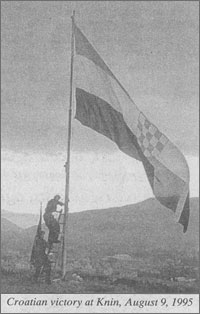
Only 4.6% of the Croatian territories were still occupied by the Serbian forces since the Storm operation in 1995 until the beginning of 1998 (the region of Baranja and eastern Slavonia), and peacefully reintegrated with the help of UN. Here we would like to mention the town of Zupanja, which was under the uninterrupted general alert for more than 2,100 days, because of almost everyday bombing and shelling.
Message of the president Franjo Tudjman to the Croatian citizens of Serbian nationality, August 4, 2005.
- War and propaganda against Croatia
- Vladimir Zerjavic: Oluja, BiH, Ahmici, etc., 2001, in Croatian
- Paul Garde: Croatie: le droit, le devoir, la necessite
- Mario Profaca: Operation Storm
- Brien Gallagher: Bleiburg - A Way Forward
- Nikola Knez: Bleiburg (film in English)
- Mario Palaich: Bleiburška tragedija 1. dio; Bleiburška tragedija 2. dio
- Mario Palaich: For Baka’s Homeland: Eyewitness To The Birth Of A State, CroLibertas Publishers, 2019 Chicago (Translation into Croatian exists: Za Hrvatsku moje bake, svjedo;anstvo o rođenju države, Chicago 2020.)
- Florian Thomas Rulitz: Bleiburška i vetrinjska tragedija (original title: Die Tragödie von Bleiburg und Viktring. Partisanengewalt in Kärnten am Beispiel der antikommunistischen Flüchtlinge im Mai 1945., published in 2011), Zagreb (published in Croatian in 2016); the English edition: The Tragedy of Bleiburg and Viktring, 1945 (published in 2016 by Northern Illinois University Press); about the author
- Mario Macek
- Andrija Hebrang: Istine i laži o Hrvatskoj, I. dio
- Andrija Hebrang: Hrvatske povijesne istine
Gallery of barbarism during the 1991-1995 aggression on Croatia:
- Hundreds of churches
- Vukovar
- Vukovar (HRT)
- Dubrovnik , a letter of Mr. Poljanic, the Dubrovnika mayor
- Links at Department of Mathematics, University of Zagreb
- Links at www.hr
- News from Croatia
- Dossier Storm
- Links at Zeljko Lupic web site, Canada
- Gifs at Department of Mathematics, University of Zagreb
Dr. Slobodan Lang:
- Dr. Slobodan Lang: Goodness has a right to be recognized as a part of truth
- Dr. Slobodan Lang and his concept of the Challenge of Goodness
- Dr. Slobodan Lang u Slatini 14.1.1994. - Matica hrvatska 42 (1:14 Slobodan Lang govori o japanskom novinaru na Bijelom Putu; 1:13:15 Branko Čulo)
- Dr. Slobodan Lang: "Storm" was humanitarian operation that prevented genocide, part 1
- Dr. Slobodan Lang: "Storm" was humanitarian operation that prevented genocide, part 2
There are more than 120 mass graves discovered in Croatia only in the period until May 1999, with about 3,000 killed, many of them massacred, victims of the 1991-1995 Greater-Serbian aggression. God knows how many mass graves are there in Bosnia-Herzegovina and in Kosovo.
Animated video describing the 1990-1995 agression on Croatia and its
liberation; 13 min.
For detailed information about the latest events in Croatia and Bosnia - Herzegovina we recommend you to visit the following web pages, maintained by Mario Profaca:
- CROATIA,
- BOSNIA -
HERZEGOVINA,
- Tihomir Blaskic prosecution, martyrdom in Bosnia and in the Hague...
 Among
outstanding Croatian generals who had a great role in liberating
occupied Croatian lands, in particular in the region of Dubrovnik
and Lika,
we
mention Janko Bobetko
(1919-2003). He described his battles in
the book Sve
moje bitke (All My Battles).
Among
outstanding Croatian generals who had a great role in liberating
occupied Croatian lands, in particular in the region of Dubrovnik
and Lika,
we
mention Janko Bobetko
(1919-2003). He described his battles in
the book Sve
moje bitke (All My Battles).
It should be pointed out that the most tragic outcome of this war is to a great extent due to the behavior of some leading European politicians, who were not willing to admit in time that Croatia was attacked (1991) and their hesitating to name the aggressor.
The reader will probably agree that even the unusual shape of Croatian borders on the map of Europe bears witness of extremely difficult history throughout many centuries.
ETHNIC
CROATIANS KILLED BY NAZI AND FASCIST FORCES DURING WORLD WAR II
John Peter Kraljic of New York and Dr. Darko Zubrinic of Zagreb, have announced the release of the initial chapter of their joint project entitled "Ethnic Croatians Killed by Nazi and Fascist Forces During World War II." The initial chapter, which can be accessed at
http://www.croatianhistory.
covers
Primorsko-Goranska County, which centers on Rijeka and includes the
Opatija Riviera, the coast to the area north of Senj, the mountainous
Gorski kotar and the islands of Krk and Rab (information for Cres,
Lošinj and their offshore islands have yet to be compiled).
Mr.
Kraljic, who holds a master's degree in history and has published a
number of studies related to Croatian history, notes that the roots of
the project can be traced back over a decade ago. "I was
curious
to see how Croatians generally commemorated events which took place
during World War II. Prior to 1990, the Communist state
manipulated those events to suit its own purposes, specifically as a
means to justify the takeover of power by the Communist Party following
the War. Croatia's democratization led to the breaking of
prior
taboos related to the War, and various institutions and individuals
began to memorialize the misdeeds of the Communist
leadership."
Mr. Kraljic goes on to note that he was "specifically interested in
seeing that many so-called Partisan monuments remained intact" despite
the traumas through which Croatia passed in the first half of the 1990s.
In his
travels, Mr. Kraljic began taking photos of these monuments.
"After having taken literally hundreds of photos, I realized that one
could attempt to construct at least a partial list of victims killed by
Nazi and Fascist forces during World War II." This is
especially
important in light of the continued attempts to paint Croatians as
being pro-fascist during the War. "These monuments, most of
them
in predominately Croat inhabited areas, clearly show the level of
suffering Croats as a whole suffered during the War, a level which is
generally not appreciated by persons not from the area."
Mr.
Kraljic decided to use the information he found on various monuments
and in available published sources to begin to construct a list of
Croatian Partisans killed during World War II as well as of Croatian
victims of fascism. He contacted Dr. Zubrinić to assist him
with
preparing the photos and the text. "We decided it would be
appropriate to publish 'Chapter 1,' covering Primorsko-Goranska County,
rather than waiting any longer." Mr. Kraljic admits that this
is
a long term project. "The fact is that driving to various
cities,
towns and hamlets, exploring innumerable cemeteries and retrieving
relevant published works is very time consuming, especially for someone
who does not live in Croatia." Mr. Kraljic continues, "to be
frank, we posted the results Primorsko-Goranska County first since I
tend to spend most of my time in Croatia in that area and have been
able to personally visit practically every settlement there." Mr.
Kraljic and Dr. Zubrinić have already begun to work on the next chapter
which will cover Istria.
Mr.
Kraljic notes that, despite the title, the intent is not to exclude any
ethnic group from the list. "Indeed, while Primorsko-Goranska
County is predominately populated by Croats, there are a number of
mostly Serb-populated settlements there, such as Moravice and hamlets
around Vrbovsko which are included. Similarly, when we deal
with
Istria, we will include ethnic Italians in the lists.
Clearly, as
we get into more ethnically mixed areas, such a Lika, the lists will
include many more Serb villages."
It is Mr. Kraljic's and Dr. Zubrinic's hope that their work will serve as a tool for researchers. "Our goal is to be as comprehensive as we possibly can be in preparing these lists, but we recognize that there will always be something overlooked in a project as wide-ranging as this one."
- Charles R. Shrader: A Muslim - Croat Civil War in Central Bosnia: A Military History 1992 - 1994, Eastern European Studies, Texas University Press, 2003
- Croatia saved Bosnia - Herzegovina, by Brian Gallagher
- Myths about Croatian role in Bosnian war
- Hrvatski memorijalno-dokumentacijski centar Domovinskog rata
- Women in Homeland War
- www.pobijeni.info
- Ethnic Croatians killed by Nazi and Fascist forces during World War II
- A letter by Ivan Mestrovic from 1955 published by Zajednicar, USA
- Ante Glibota: LES CAUSES DE LA PREMIERE GUERRE MONDIALE ET LES IMPACTS SUR LES RELATIONS INTERNATIONALES AU XXÈME SIÈCLE, Paris 2018, UNESCO conference CENT ANS APRES LA PREMIERE GUERRE MONDIALE, QUELLE LEÇON EN TIRER POUR L'HUMANITE ?
- Luka Brajnovic: Despedidas y encuentros / Memorias de la guerra y el exillio, EUNSA - Ediciones Universidad de Navarra, 2001, 2nd edition also exists (Croatian translation published in 2019: Oproštaji i susreti / Sjećanja iz rata i izgnanstva)
- www.youtube.com/watch?v=n7JHtFoKmfU&t=32s
Intro by NFCA Steve Rukavina & Luka Misetic Presentation: Military Operations in August-October '95 - www.youtube.com/watch?v=6sefwjea9wM
25th Anniversary Dayton Peace Accord Discussion with former Ambassador to Croatia Peter Galbraith - www.youtube.com/watch?v=yplJQLGhKYk&list=PLLcXQ8hmE-ee7MTAgELRZZjA_jrZYTmUP&index=4
Dayton Peace Accord Discussion-BiH Constitutional issues with Professor Dražen Barbarić (Mostar) - Dr. Dražen Švagelj, Vinkovci
- Ina Vukic: Blanka Matkovic Book On Communist Crimes
- Blanka Matkovic
- Stjepan Lozo: Ideologija i propaganda velikosrpskoga genocida nad Hrvatima: projekt „Homogena Srbija“ 1941., Naklada Bošković, Split, 2017. (2. izd. 2018., 3. izd. 2019., 4. izd. 2020.), video - Hrvatski državni arhiv, podcast Velebit, LaudatoTV
Croatia - its History, Culture and Science
